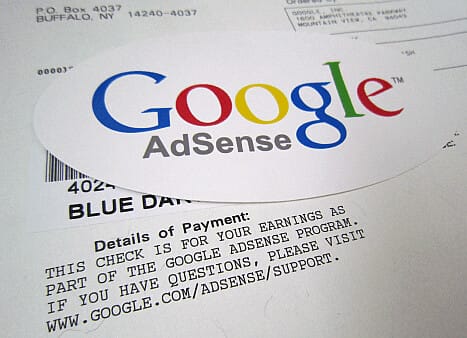What is Google AdSense? (And How I Got In After 3 Soul-Crushing Rejections)
So, What Is Google AdSense?
Let’s say you’ve built a shiny new website. It’s got content. It’s got charm. It’s got you pouring your heart, soul, and about 47 cups of coffee into it.
But when you proudly check your bank account? Yeah… it’s emptier than my fridge at the end of the month.
Enter Google AdSense — Google’s way of saying:
“Hey, you’ve got traffic. Want to slap some ads on your site and make a little money?”
Table of Contents
In short, Google AdSense is a free program by Google that lets you display ads on your website and earn money when people view or click them (official guide here).
Think of it like Airbnb, but instead of renting your spare bedroom, you’re renting out little rectangles (pixels) on your webpage.
Now, let’s get into the nitty-gritty—how AdSense works, what it takes to get approved, why Google’s review process can be as unpredictable as a cat on espresso, and how I finally cracked the code after three rejections and one awkward-but-glorious victory dance.
How Does Google AdSense Work?
Let’s break it down like a frustrated dance instructor:
- You apply for AdSense.
- Google reviews your website.
- If they like what they see (clean layout, quality content, no shady business), you get accepted.
- Ads magically appear on your site.
- Visitors click (or even just view) the ads.
- You earn money. (Cue confetti. Or at least, a cupcake.)
Sounds simple? Ha. Cute.
The truth is, getting approved for AdSense is like trying to impress a super picky landlord. One typo, one “Under Construction” page, or one grainy stock photo—and it’s “Sorry, not eligible.”
If you’ve ever struggled with why your website isn’t ranking, you’ll recognize the same vibe here: Google wants things just right.
My 3-Time Rejection Saga (And the Glorious 4th Win)
Let me share a little story I like to call: “How I Learned to Stop Panicking and Love the AdSense Review Process.”
- First Try: I applied with a site that had three blog posts, a janky homepage, and a “Coming Soon” section that had been “coming” for two months. Google took one look and said, “Bless your heart. Denied.”
- Second Try: I added more content, slapped on a nice-looking theme, and removed the “coming soon” lie. Result? Another rejection. Reason: “Insufficient content.” Apparently, six articles on why cats are superior to dogs wasn’t “enough.” At this point, even my cat looked disappointed.
- Third Try: I went full-blown perfectionist—like the kind of person who irons socks. I fixed grammar, added an About page, cleaned up navigation, and even created a contact form (because maybe Google wanted to say hi?). Rejected. Again.
- Fourth Try: I finally got smart. I stopped overthinking and just focused on useful, original content. I added privacy and disclaimer pages, kept my design clean, and ditched the keyword stuffing.
Boom. Approved. Sweet, sweet approval. Did I cry? I’ll neither confirm nor deny.
Key Things You Need to Get Approved for AdSense (Without Crying)
1. Have Original, High-Quality Content
Don’t just rewrite Wikipedia and expect dollar bills. Google wants:
- Unique voice
- Helpful insights
- Decent length (at least 600–800 words per post)
- No copy-paste nonsense
My Tip: Write like you’re helping your slightly confused but lovable cousin understand the topic.
If you need inspiration, check out my Astra WordPress Theme review — notice how I broke it down for beginners without drowning them in jargon.
2. Build Out Essential Pages
These are like your VIP passes. Without them, Google thinks you’re sketchy:
- About Page – Who are you? What’s this site about?
- Privacy Policy – Because data is serious business.
- Disclaimer Page – Especially if you give advice.
- Contact Page – So humans (and bots) can reach you.
My Mistake: I thought “About Me” was optional. Google said, “Nice try.”
3. A Clean, Mobile-Friendly Design
Your site should look like it was built in this decade. That means:
- No blinking text from 1998
- Works well on mobile
- Easy navigation
- Fast loading
I personally switched to a clean Sydney WordPress theme, shaved 3 seconds off my load time, and boom—Google finally stopped side-eyeing me.
4. No “Under Construction” Pages or Broken Links
Google doesn’t want half-baked dreams. They want a fully-functioning, delicious content cake. So:
- Delete “Coming Soon” or “Hello World” placeholders
- Check that all links actually go somewhere
Personal Burn: I had a link pointing to “/dead-end.” Guess what? Google noticed.
5. At Least 15–20 Posts With Real Value
This is the golden zone. If you have:
- 15+ solid posts
- Topics that solve real problems
- Clear formatting (headings, lists, images)
You’re in a good place. For example, I didn’t just publish what is Wix Web Builder overnight—it took effort to make it helpful and beginner-friendly.
6. No Copyrighted or Restricted Content
Avoid:
- Pirated movies/music
- Adult content
- Weapons, drugs, shady business
Google is basically the internet police. They will catch you.
7. Stick to a Niche (or at Least Consistent Quality)
Don’t post about Bitcoin one day, banana bread the next, and conspiracy theories after that. Pick a theme—or at least a voice.
I chose tech-for-beginners, kept it funny and practical (see my Google AdWords guide), and eventually Google said, “Fine. You’re in.”
What Happens After You’re Approved?
First, celebrate. Blast some music. Do the dance. But then:
- Set up ads with the code Google gives you.
- Watch the data roll in (impressions, clicks, CTR).
- Refresh your dashboard 87 times a day (it won’t make numbers grow faster, trust me).
- Once you hit $100, Google pays you (payout guide). Direct deposit = happiness.
⚠️ Warning: Don’t click your own ads. That’s the fastest way to get banned forever.
How Much Money Can You Make?
Here’s the un-sugarcoated truth:
- 10 visitors a day = $0.02 a week
- 1,000 visitors a day = maybe $5–$20/day depending on niche
So no, it’s not a get-rich-quick scheme. It’s more like a get-instant-noodles-money-slowly scheme.
Is Google AdSense Still Worth It?
Yes—if you:
- Have steady traffic
- Publish regularly
- Don’t expect to retire on it (yet)
It’s passive income, but it takes active effort. Honestly, my first $100 felt better than birthday money from grandma.
Final Thoughts: AdSense and You (A Love-Hate Relationship)
Google AdSense is a great first step for monetizing a website. But it comes with quirks, mysteries, and heartbreaks.
If you’ve been rejected? Don’t give up. I got in on the fourth try. You might need five. Or six. Or maybe you’re one of those lucky one-try wonders (we don’t talk to those people… just kidding. Kind of).
The key is: keep improving your site, focus on real value, and don’t rush it. You’re building an online house—make sure it doesn’t collapse at the first gust of Google’s algorithm wind.
Mine had leaky windows and a broken door at first, but hey—it’s standing now. Yours will too.
You May Also Like on Voob.com.ng
- Astra WordPress Theme Review
- Sydney WordPress Theme Review
- Betheme WordPress Theme Review
- What is Wix Web Builder?
- Why is Your Website Not Ranking High on Search engine
Hi, I’m Prince Stephen Mordi, the mind behind Voob.com.ng. I write simple, beginner-friendly guides on tech, blogging, and making money online. My goal is to help you navigate the internet without headaches—because tech doesn’t have to be complicated!





